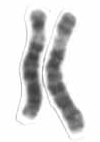Chromosome 6 (human)
| Chromosome 6 (human) | |
|---|---|

Human chromosome 6 pair after G-banding.
One is from mother, one is from father. |
|

Chromosome 6 pair in human male karyogram.
|
|
| Features | |
| Length (bp) | 170,805,979 bp |
| Number of genes | 3,000 2,516 |
| Type | Autosome |
| Centromere position | Submetacentric |
| Identifiers | |
| RefSeq | NC_000006 |
| GenBank | CM000668 |
Chromosome 6 is one of the 23 pairs of chromosomes in humans. People normally have two copies of this chromosome. Chromosome 6 spans more than 170 million base pairs (the building material of DNA) and represents between 5.5 and 6% of the total DNA in cells. It contains the , which contains over 100 genes related to the immune response, and plays a vital role in organ transplantation.
Identifying genes on each chromosome is an active area of genetic research. Because researchers use different approaches to genome annotation their predictions of the number of genes on each chromosome varies. In January 2017, two estimates differed by 16%, with one estimate giving 3,000 genes, and the other estimate giving 2,516 genes.
In 2003, the entirety of chromosome 6 was manually annotated for proteins, resulting in the identification of 1,557 genes, and 633 pseudogenes.
The human leukocyte antigen lies on chromosome 6 (exception: the gene for β2-microglobulin which is located on chromosome 15), and encodes cell-surface antigen-presenting proteins among other functions. The following are some of the genes and their corresponding Cytogenetic location on chromosome 6:
The following diseases are some of those related to genes on chromosome 6:
...
Wikipedia
